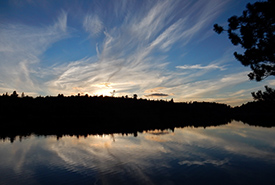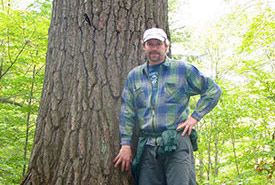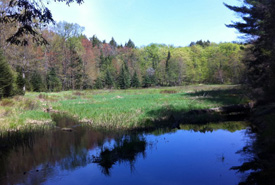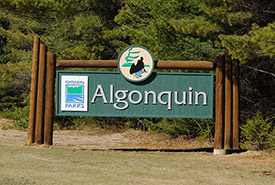International Day of Biological Diversity: A thank you note to Algonquin Park

Joe Lake, Algonquin Provincial Park (Photo by Brett Hodnett/Wikimedia Commons)
Three.
That’s how many Nature Conservancy of Canada (NCC) supporters recently (within the span of a week) shared with me that their current passion for nature and support for our work at NCC was sparked by spending time in Algonquin Park during their youth.
It’s no wonder. Algonquin Provincial Park holds a special, almost mythical place in our Canadian narrative of parks and wild places. Established in 1893 (originally as Algonquin National Park), it was only the fifth protected area established by a new Canadian Confederation. It was created in an age when we weren’t even certain what parks were for. The original proposal to establish Algonquin stated that the new park would protect water supplies and the then dwindling populations of game and fur-bearing animals [1].
And it worked. The headwaters of the Madawaska, Oxtongue, Petawawa and other rivers are protected in the forests and wetlands of the Algonquin highlands, and beaver, moose and other animals recovered and thrived in the newly created park.
Having grown up in southern Ontario with a camping family, I share the sentiments of those NCC supporters that Algonquin Park is a magical place with the ability to sear lasting memories. I can still smell our old canvas tent, and I remember seeing my first beaver before it slapped its tail and disappeared beneath a lily-covered pond. Immersion in complex and sometimes unpredictable outdoor experiences impacted me more than anything I ever learned in school or from gazing at a two-dimensional screen.

Dan Kraus with a big, old-growth white pine in Algonquin Park, ON (Photo courtesy of Dan Kraus/ NCC staff)
Parks and protected areas are important for many reasons. Today as a scientist, I’m focused on how NCC can conserve more of Canada’s lands, waters and wildlife. But often, parks and protected areas have an impact that extends well beyond their boundaries. Not only do places like Algonquin Park protect wildlife and important habitats, they also provide a place where people can connect with the natural world. They are an incubator for knowledge, empathy and love for nature.
Algonquin Park is not unique in providing a stage for the ecology of experience. Early experiences with nature have changed the lives of many Canadians. I’ve met people whose passion for Canadian nature and support for conservation was sparked by the ravines of Toronto, the back forty of their farm or a family visit to the mountains or a beach.
It does worry me that there are Canadians growing up without the experience of campfire smoke, surprise encounters with wildlife and the anticipation of what lies around the bend. A few generations ago, almost every Canadian child had an opportunity to connect with nature. Canada was a rural nation, and kids had time to explore. Today, most of us live in cities, and our children have the busy schedules of CEOs.

Western uplands landscape at Algonquin Provincial Park (Photo by Cara Copeland/NCC Staff)
But as Canadians, we are fortunate. The opportunity for that connection with nature awaits everyone — in city parks, nearby natural areas or family vacations to Algonquin Park. But we need to create the opportunity, and the future of conservation might depend on it.
I think a lot about numbers. Canada’s target to protect 17 per cent of its lands and inland waters by 2020, NCC’s new goal of working with partners under the Natural Heritage Conservation Program to protect an additional 200,000 hectares (494,210 acres), or how to stop the loss of Canada’s 797 species that have been assessed as at risk. These numbers are useful, but they do not drive or inspire conservation. Conservation comes from knowing and feeling that nature is important. Important to our culture, important to our communities and traditions and important to each of us on a uniquely personal level. It is our experiences, perceptions and love of land, water and wildlife that matter most. If Canadians have a relationship with nature, the right numbers will follow.

Algonquin Provincial Park entrance sign (Photo by Wladyslaw/Wikimedia Commons)
The places we protect today are going to be valued by future generations, maybe more than anything else we can leave behind. I’m grateful to the people who created Algonquin Park. It helped stop the loss of biodiversity and continues to benefit nature and people today. Some of my best memories still live there. There’s not much that we have in Canada created 126 years ago that still benefits so many Canadians.
In a world where we are rapidly losing wild species and wild spaces, there is urgency in our work. To leave behind places that protect wildlife, support local economies and well-being, and ensure our Canadian bond to nature holds strong. But we need to act fast and act now.
Future generations will thank us.
1. Province of Ontario, Report of the Ontario Royal Commission on Forest Reservation and National Park. 1893, The Legislative Assembly: Toronto.


